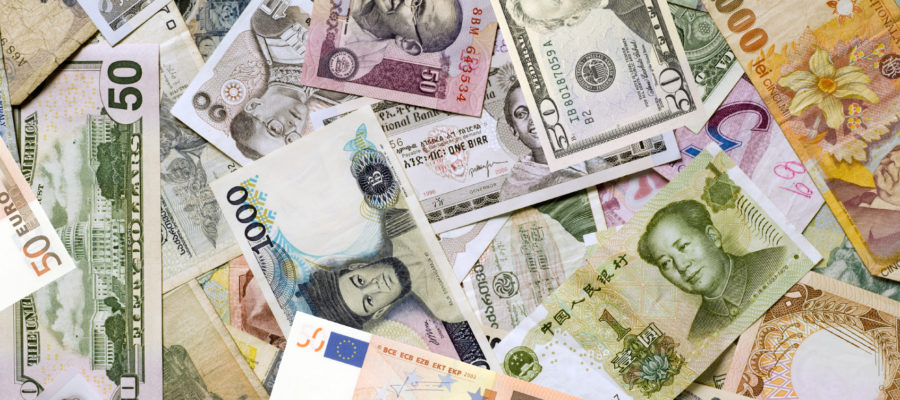
Since the financial crisis set in motion the largest monetary experiments in recent history, accusations of “currency wars”, or “currency manipulation”, have been commonplace. These reflect the predominant liberal dogma, which dictates that exchange rates should be determined by market forces, with the role of central banks limited to silently observe as bystanders. Any attempt to influence the value of a currency represents a menace to the system that should be denounced. The US acts as the main guardian of the regime, and enacts a “Monitoring List” of deviant members, currently featuring China, Korea, Taiwan, Japan, Germany and Switzerland.
Floating exchange rates however are a modern invention. Historically, currencies have been fixed to a commodity or to another currency. The demise of the Bretton Woods regime in 1973 put an end to the convertibility of the dollar into gold, and with that ushered the era of free-floating fiduciary currencies.
The transfer into markets’ hands was more chaotic than initially expected and repent led to several attempts to coerce market freedom. A number of patches ensued, like the European Monetary System (EMS) in 1979 and the Plaza and Louvre Accords (1985-87). Total capitulation occurred in 1992, when Soros broke the Bank of England and forced the UK to leave the EMS. The humiliating defeat of such a venerable central bank was a telling lesson for others, and marked a decisive victory for capitalism. Exchange rate controls had a negative side effect: they required capital controls. Their removal coincided with the implementation of the Basel Accord for cross-border banking supervision, triggering the globalization of capital witnessed during the past few decades.
Although floating exchange rates are nowadays the norm, the fact that governments let the markets set price of a key public good constitutes a singularity. In fact, it is usually the case that governments intervene when there is a market failure, and not the other way around. The lack of success of fixed exchange rates partially stems from what is known in finance as the “Impossible Trinity”, which states that a central bank cannot, on its own, pursue at the same time a fixed exchange rate, an independent monetary policy, and free movement of capital. With fiduciary currencies however, this constraint could be overcome if countries would agree to cooperate – Bretton Woods ultimately imploded because of the link to gold, but fiduciary currencies can be created at central banks’ discretion.
However, the problem is bigger than one of collective action, as a precondition for mutual cooperation is to have an agreed framework for determining the equilibrium exchange rates. Contrary to other financial assets where an accepted valuation methodology exists – reducing the problem to informing the variables of the model – in currencies the best we have is a patchwork of loosely related theories based on differentials in purchasing power, interest rates, growth and inflation. The state of affairs is so poor that the foreign exchange market is credited for being the only one in which an arcane forecasting technique known as “Technical Analysis” produces positive empirical results.
In the absence of a guiding principle, the law of supply and demand may be the best price discovery mechanism that we have. However, markets are not infallible, and it is far from obvious that countries should just stomach the extreme macroeconomic stress that floating exchange rates can provoke. Doing this may actually lead to subordinating all policy tools to the market. In fact, the US Treasury expects countries under supervision to adjust their monetary and fiscal policies in order to allow for a fully market-driven exchange rate, and stops just short of asking Germany to produce mediocre cars in order to correct its trade surplus.
Admitting one’s ignorance is a prerequisite for gaining knowledge; however, reason is often leapfrogged by faith. It would be far more productive if, instead of pointing fingers at those who do not worship the market, more efforts were devoted to developing a theory that could be used as a reliable tool for determining fair exchange rates. This could help to return the authority to set exchange rates back into public hands, or at least to better substantiate accusations of currency manipulation.
Fernando de Frutos, MWM Chief Investment Officer
* This document is for information purposes only and does not constitute, and may not be construed as, a recommendation, offer or solicitation to buy or sell any securities and/or assets mentioned herein. Nor may the information contained herein be considered as definitive, because it is subject to unforeseeable changes and amendments.
Past performance does not guarantee future performance, and none of the information is intended to suggest that any of the returns set forth herein will be obtained in the future.
The fact that BCM can provide information regarding the status, development, evaluation, etc. in relation to markets or specific assets cannot be construed as a commitment or guarantee of performance; and BCM does not assume any liability for the performance of these assets or markets.
Data on investment stocks, their yields and other characteristics are based on or derived from information from reliable sources, which are generally available to the general public, and do not represent a commitment, warranty or liability of BCM.


